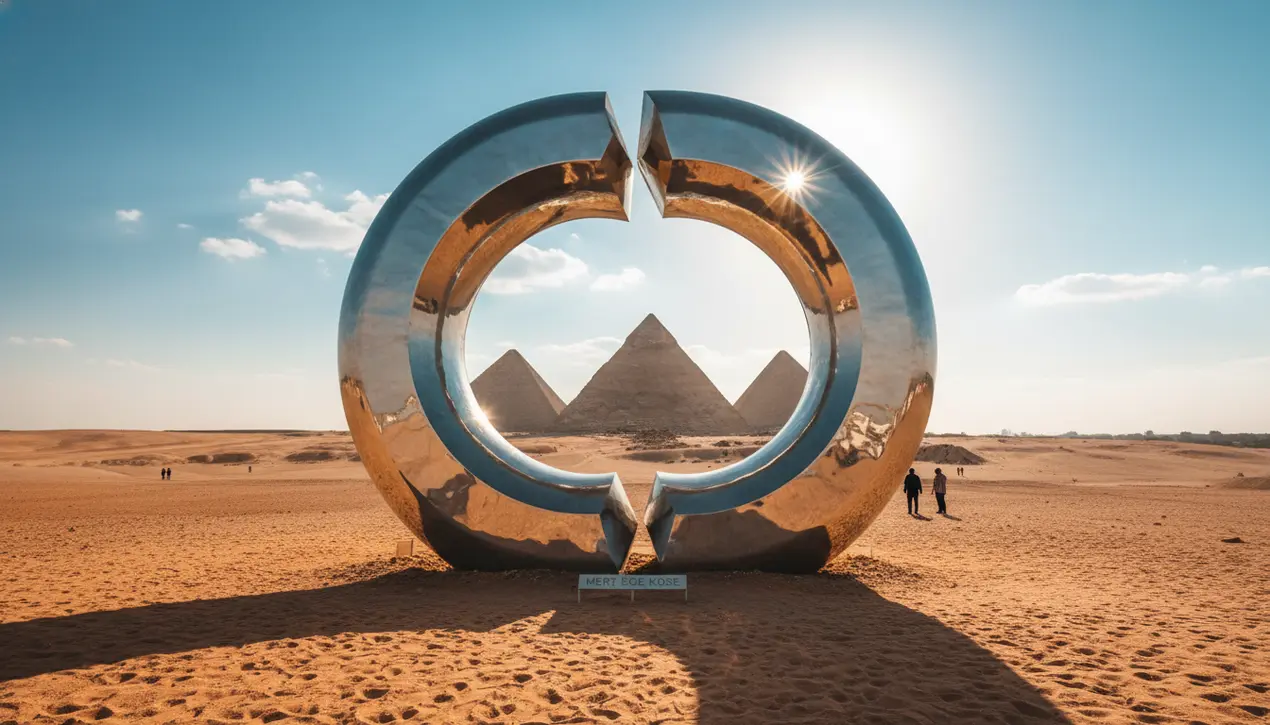
Entertainmenttheatre & artsArt Exhibitions
Reflective Aluminum Sculpture Splits to Frame Giza Pyramids
SO
Sophia King
2 hours ago7 min read1 comments
In the vast, sun-baked expanse of the Giza Plateau, where ancient history seems to breathe from the very sand, a new form of divine geometry has emerged, not from the past, but from the mind of a contemporary artist. Mert Ege Köse has reimagined the ancient Egyptian shen ring, a symbol of eternal protection and infinite completeness, not as a flat hieroglyph but as a breathtaking, three-dimensional volume.Crafted from highly reflective, mirror-polished aluminum, the sculpture is a study in mathematically calibrated curves, a form that feels both ancient and impossibly futuristic. Its most captivating feature is its ability to split apart, its two halves separating to create a perfect, dynamic frame through which the timeless Giza Pyramids are viewed.This is not merely a static object placed in a landscape; it is an interactive portal, a dialogue between millennia. The reflective surface acts as a canvas for the environment, capturing the brilliant blues of the Egyptian sky, the golden hues of the desert, and the monumental presence of the pyramids themselves, effectively dissolving the sculpture into its surroundings and forcing a reconsideration of both the man-made and the natural.For those of us enthralled by the intersection of art and technology, Köse’s work is a profound example of how digital tools—the algorithms that define those perfect curves, the precision engineering required for the flawless split—can serve a deeply human and spiritual purpose. It’s reminiscent of using a sophisticated AI art tool like Midjourney, where a simple prompt can generate infinite variations, but here, the artist’s intent is physically manifest, a deliberate act of creation that bridges the algorithmic and the tangible.The shen ring, traditionally a loop of rope, symbolized everything from the sun’s orbit to a cartouche’s protection of a pharaoh’s name; by re-engineering it as a split volume, Köse injects a modern narrative of perspective, of seeing the old through a new, fractured lens. This act of framing is a powerful artistic gesture, not unlike how a UX designer frames a user’s journey through an app, guiding the eye and the experience toward a specific, meaningful endpoint.The sculpture doesn't compete with the pyramids; it collaborates with them, its sleek, minimalist form and high-tech material providing a stark, beautiful contrast to the rough, weathered limestone. It raises compelling questions about permanence and reflection—both literal and metaphorical.Where the pyramids were built for eternity, this aluminum intervention is transient, a temporary conversation with the ages. Its mirror-like skin reflects our own moment in time back at us, even as it shows us one of humanity’s oldest achievements.This project, presented as part of initiatives like Art d’Egypte, signals a vibrant future for public art, where technology is not a cold, separate entity but a partner in creating experiences that are as emotionally resonant as they are intellectually stimulating. It’s a testament to the idea that the next great canvas isn't just a screen; it's the physical world itself, waiting for artists like Köse to use the tools of our time to help us see it anew.
#featured
#Mert Ege Köse
#sculpture
#Shen Ring
#Giza Pyramids
#reflective aluminum
#contemporary art
#Egyptian heritage
Stay Informed. Act Smarter.
Get weekly highlights, major headlines, and expert insights — then put your knowledge to work in our live prediction markets.
Comments
Loading comments...
© 2025 Outpoll Service LTD. All rights reserved.